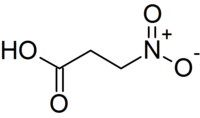Beta-Nitropropionic acid

| |
| Names | |
|---|---|
|
Preferred IUPAC name
3-Nitropropanoic acid | |
| Other names
3-Nitropropionic acid; β-Nitropropanoic acid; BPA; 3-NPA
| |
| Identifiers | |
|
|
|
3D model (JSmol)
|
|
| ChemSpider | |
| ECHA InfoCard | 100.007.276 |
|
PubChem CID
|
|
| UNII | |
|
CompTox Dashboard (EPA)
|
|
| |
| |
| Properties | |
| C3H5NO4 | |
| Molar mass | 119.076 g·mol−1 |
| Melting point | 65–67 °C (149–153 °F; 338–340 K) |
|
Except where otherwise noted, data are given for materials in their standard state (at 25 °C [77 °F], 100 kPa).
| |
β-Nitropropionic acid (3-nitropropanoic acid, BPA, 3-NPA) is a mycotoxin, a potent mitochondrial inhibitor, which is toxic to humans. It is produced by a number of fungi, and may be found widely in food such as in sugar cane as well as Japanese fungally fermented staples, including miso, soy sauce, katsuobushi,coconuts and some traditional Chinese medicines.
It can be caused by extreme weather, stressed crop growth conditions, as well as storage conditions (like moisture), which can give a further rise under global warming conditions.Arthrinium caricicola and Arthrinium saccharicola are known to produce 3-nitropropanoic acid.
It is found that 3-nitropropionic acid is a mitochondrial toxin and produces striatal alterations in rats similar to those observed in the brain of Huntington’s disease patients, and administration of the cannabinoid receptor agonist WIN55212-2 to rats for six consecutive days, before the 3-NPA injection, exerted preventive effects on all alterations elicited by the toxin, like mitochondrial dysfunction and lipid peroxidation, by activation of the CB1 receptor.
